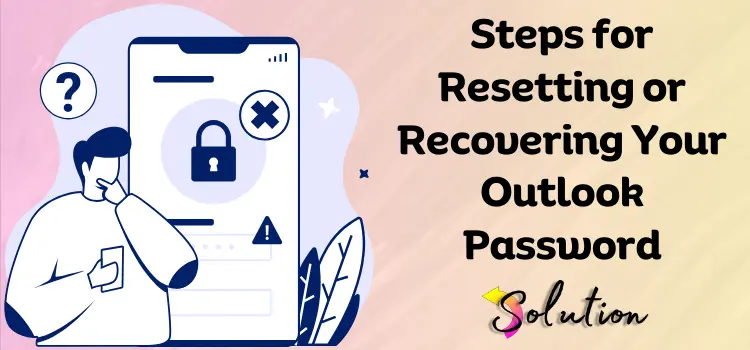
Outlook password reset is a simple step that secures your account and personal information. Whether you’ve forgotten your password or need to change it due to privacy concerns, Microsoft offers simple ways to restore access or safeguard your account. Forgotten passwords may be irritating, but with a few simple steps, you can reset them using your registered email, phone number, or security questions.
On the other hand, privacy concerns or suspected activities necessitate prompt action to protect your account. Microsoft’s comprehensive security safeguards enable users to quickly update their passwords, monitor account activity, and deploy sophisticated security approaches such as two-factor authentication. Understanding how to change Outlook password in both scenarios is critical for keeping your account secure and avoiding illegal access.
The procedure normally includes authenticating your identity, generating a secure new password, and upgrading recovery options to ensure future access. Users can also utilize security tools such as the Microsoft Security Dashboard to monitor account activity and increase defenses against possible intrusions. This tutorial will lead you through each scenario, including specific methods for effortlessly resetting your Outlook password and advice to improve account security.
Essential Points to Remember for a Smooth Recovery Process
While the process of reset or change Outlook password is straightforward, it is advisable to take precautions in advance to save time and effort. A minimal amount of preparation can significantly facilitate a seamless and stress-free process. Are you interested in learning how to simplify and enhance the security of your situations? For a seamless password restoration experience, refer to the following essential tips:
- Make sure you can access the email or phone number linked with your Microsoft account.
- If you do not have access to any recovery alternatives, click the “I don’t have any of these” link to complete out the account recovery form. This may require additional time for verification.
- Keep your recovery choices (email and phone number) up to date to avoid future problems.
How to Reset A Forgotten Outlook Password
Forgetting your Outlook password may be irritating, but resetting it is straightforward. Microsoft provides simple recovery methods utilizing your registered email address, phone number, or security information. You may authenticate your identity and establish a new password in a few simple steps. This allows for rapid access to your account while keeping your information secure.
- First, open your computer browser and go to the Microsoft Account Password Reset page.
- Select the option “I forgot my password“.
- Select the Next option and enter the email address associated with your Outlook account.
- Then, input the Captcha characters that appear on the screen to establish that you are not a robot.
- Now, click the Next tab, and Microsoft will prompt you to verify your identity using one of the best methods linked with your account.
- Verification by email
- Phone verification
- Security questions and other alternatives
- Microsoft will ask you to create a new password after validating your identity.
- Write down and confirm your new password.
- Once the new password is validated, click the Next tab.
- Go to the Outlook sign-in page.
- Enter your new password to access your account. This is how you can handle the Outlook password forgot situation.
Steps-by-Step Instructions for How to Change Outlook Password
If you believe your Outlook account has been hacked, or you are experiencing threats or privacy concerns, changing your password right away is critical to securing your account. Here are step-by-step instructions for an Outlook password reset in such cases:
- Navigate to the Microsoft Sign-In page.
- Enter your email address and current password.
- Once logged in, click the Profile Image.
- Choose the My Microsoft Account option.
- Then, select the Security tab or go to the Security Dashboard.
- Next, reset your password using one of the two methods described below:
- Option 1: If you can access your account.
- Go to the Security section and choose the Change Password option.
- Simply authenticate your identity with one of the offered options.
- Make a note of both your current and new strong passwords.
- Click the “Save” tab to finalize the process and verify the new password.
- Option 2: In case that you are unable to access your account.
- Visit the Microsoft Account Password Reset page.
- Select the option “I suspect that someone else is utilizing my account.”
- Click on the Next tab and input your email address.
- Complete the CAPTCHA and then select the Next tab.
- Next, go through the verification procedure to establish your identity.
- After validating, generate a strong new password and save it.
How to protect your account against future threats
With the fast evolution of technology, new risks develop on a regular basis, as do innovative solutions to counter them. As cyber hazards increase, so does the innovation in protection measures, which provide greater defenses than ever before. Curious about how these developments can protect your data? Continue reading to learn about the benefits of current technology in combating cybercrime and protecting your personal information!
A). Secure Your Account
Securing your account from cyber attacks has never been easier thanks to contemporary technologies! Enabling two-factor verification allows you to easily add an extra degree of safety. Are you interested in learning how to configure it? Follow the easy instructions below to take charge of your online security today—no ambiguity, just straightforward measures to keep your account secure!
Step 1: Two-Step Verification
- Go to the Security Dashboard.
- Click on the Advanced Security Options.
- Enable Two-Step Verification and follow the instructions to set it up using your phone number or an authentication app.
Step 2: Review Account Activity:
- Check the Security Dashboard’s Recent Activity section.
- Here, verify for any unusual sign-ins or changes.
- If you observe any fraudulent activity, click on the Secure Your Account.
Step 3: Update the recovery information:
- Check the Account Info section to ensure that your backup email and phone number are up to date.
Step 4: Revoke Access to Connected Devices:
- Go to Security Settings and log out of all devices.
- Re-login with your new password only on trustworthy devices.
B). Report Privacy Threats
Reporting privacy hazards is an effective strategy to protect your account from cyber attacks and sensitive data. By acting quickly, you may avoid possible compromises and secure your digital life. If you have privacy concerns, don’t wait—take the further procedures suggested below. This will assist you in maintaining your safety and control.
- Contact Microsoft Support: Report any suspicious activities or threats using the Microsoft Support Page.
- Enable Advanced Threat Protection (ATP): For corporate or premium accounts, utilize ATP to detect and stop phishing emails.
- Inform Authorities: If the threats are serious, report them to local law enforcement.
C). Monitor and Maintain Account Security
In these days of advanced technology, it is more crucial than ever to protect your account security. Regularly monitoring and updating your account protects your password against potential threats and unwanted access. Taking preemptive steps might help you keep ahead of cyber threats. Want to understand how to keep your accounts secure? Continue reading for vital password protection tips!
- Regularly change your password.
- Avoid disclosing your password or account information with anybody.
- Be wary of phishing emails or links that might compromise your account.
Read Also:- How Do I Fix Outlook Email Not Working
End note!
In conclusion, updating or recovering your Outlook password is a straightforward yet vital step in safeguarding your account. Whether it’s due to a forgotten password or a privacy update, Microsoft offers an efficient recovery process to help you regain access quickly. Strengthen your security by verifying your identity, setting a robust new password, and keeping recovery details updated. Adding features like two-factor authentication enhances your account’s safety, providing an extra barrier against unauthorized access. Being proactive with these measures ensures your sensitive information stays protected and minimizes potential risks in the future.


